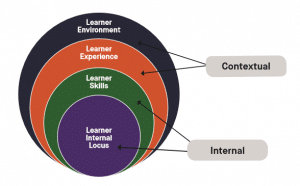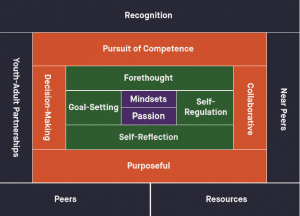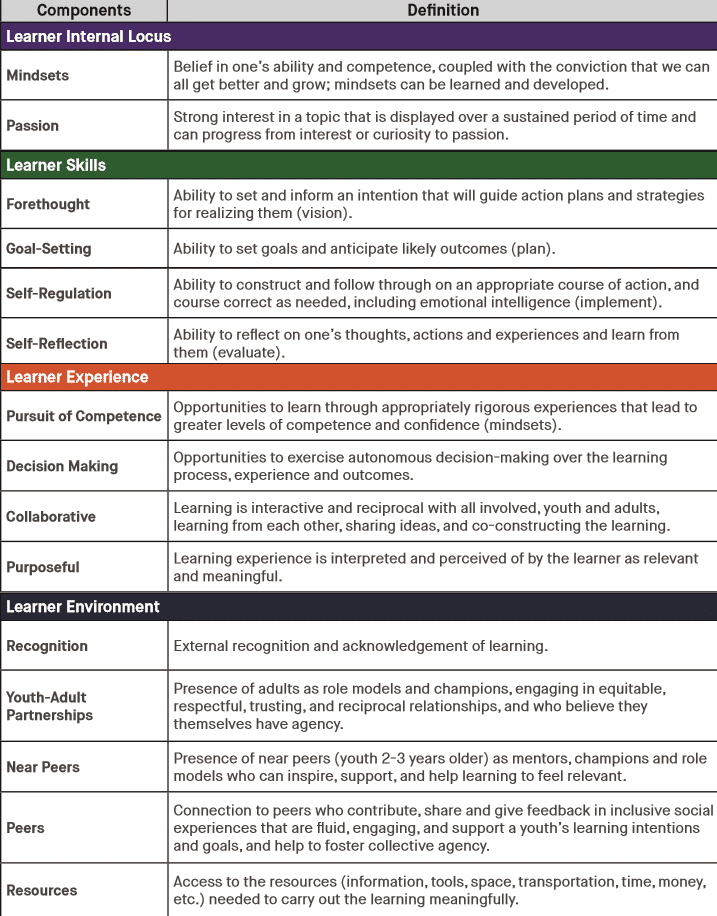Pioneering the New Way of Learning: Learner Agency and Opportunity
CompetencyWorks Blog

This article was originally posted at iNACOL on January 31, 2017. We share this article as it provides an in-depth model for thinking about how to build learner agency.
Testing the Ingredients to Learner Agency Success… Through Learners
We are members of GripTape’s Youth Leadership Board which is composed of youth in high school and college who have set out on a journey to change the view of education for youth everywhere. Through weekly video conferences, new ideas are created, content is contributed, and there is an endless amount of support. The Board was created a little over a year ago, and has already created so much for youth learners throughout the nation. It will be exciting to see what can be accomplished within the next year and years to come.
Being able to serve as members on this Board hasn’t only given us the chance to exercise and develop our leadership skills, but also the chance to discover why it is so powerful. Every single member on our Board has a unique talent to share and a unique question they aim to find the answer to. Each of us are on our own individual journeys as to assure that we never cease the learning process ourselves. And the ways each of us go about doing so is tied into the unique skillset we each bring to every meeting.
Understanding Motives and Inspirations
Griptape is focused around the goal of placing young learners in the path of other potential learners to build an extensive network of learners. That is the premise of our work: providing awareness to youth of their untapped potential to learn anything that they want. This process has taken much time and collaboration between organizations, professionals, youth, and a pretty awesome youth-led Board. With all this creativity, knowledge, and experience, a guideline was put together to encompass all the aspects which essentially help “facilitate the emergence of learner agency.” The following ideas were put together on what is believed to be factors in enabling and maintaining productive and positive learner agency. Then this framework was looked over once and look over some more and probably will continue to be reviewed and revised in the future. The idea behind the framework is that learner agency first begins internally with the learners own set of beliefs and ambitions, then can be demonstrated depending on the learner’s external influences and relative practices that eventually shape their experience and environment. Knowing what can motivate and inspire youth to pursue learning outside of the classroom, once broken down, is actually not all that difficult. The greatest challenge presented with learner agency is getting the message to every young person around the world that they are actually capable of learning anything they want to!
Framework Components/Subcomponents
The diagram to the right illustrates how we have come to view the emergence and growth of learner agency as an inside transformation growing into something that can change a learners’ perspective on their future in education.  Metaphorically, this diagram can be viewed as a flower seed being planted with limited resources and support. This seed wants to find its purpose, but without understanding their self and what motivates them, it can become a difficult expedition that sometimes goes unexplored. However, in an unexplainable strike of luck, it clicks. It can’t be described what clicks, how it happens, or where it comes from besides the fact that it happens out of nowhere and then a learner finds passion in something they want to learn. Then the process starts, the ruthless growing of that at first, unsupported flower seed to become more than a seed and contribute something to its own growth and place in the world. Through research, experience, listening, learning, and applying, the small, delicate flower now wants to become a giant oak tree and contribute something that the rest of the oxygen-breathing world would have to acknowledge (or it can want to just remain a flower, too and influence those around them to become oak trees, either is great honestly).
Metaphorically, this diagram can be viewed as a flower seed being planted with limited resources and support. This seed wants to find its purpose, but without understanding their self and what motivates them, it can become a difficult expedition that sometimes goes unexplored. However, in an unexplainable strike of luck, it clicks. It can’t be described what clicks, how it happens, or where it comes from besides the fact that it happens out of nowhere and then a learner finds passion in something they want to learn. Then the process starts, the ruthless growing of that at first, unsupported flower seed to become more than a seed and contribute something to its own growth and place in the world. Through research, experience, listening, learning, and applying, the small, delicate flower now wants to become a giant oak tree and contribute something that the rest of the oxygen-breathing world would have to acknowledge (or it can want to just remain a flower, too and influence those around them to become oak trees, either is great honestly).
Endless Possibilities Through Lifelong Journeys…
The framework components show only a glimpse of the possibilities a learner has once they realize their own “locus” or drive, including: learning more and developing skills to be better; growing their knowledge and background about the information; the ability to impact their environment (friends, siblings, adults, etc.), community (school, organizations, businesses, etc.), or possibly the world. There is no way to know how far someone can go once they start to pursue their passions. This is not just limited to learners in school, but the lifelong learning journey!!
The paragraphs below further explain each component in more detail.
Internal: The first two components are internal, representing the learner’s own beliefs and actual and perceived capacity to exercise control over their own learning, and are driven by their own interests.
Learner Internal Locus is an individual learner’s belief in their ability to exercise control over their learning and their desire to do so. It is important to note that these beliefs can be learned and developed. In many ways, this is the most critical of our four components, directly impacting how all other influences are enacted and perceived. Time and time again, research has shown that youth who believe in their self-efficacy out-perform and out-persist even their more competent peers (Morton & Montgomery, 2011; Dweck, 2006).
Learner Skills are what a learner must practice and gain competence in to effectively contribute to, influence and guide their learning. While the internal locus can propel a learner on the path, completing that learning journey requires a set of core intrapersonal and meta-cognitive competencies, all of which can be learned through practice, as well as a deeper understanding of one’s own learning styles and preferences.
Contextual: The second set of components are the external contexts and influences that can have a profound effect on a young person’s ability, desire, and willingness to take ownership over their process of learning. While external, it is important to note that youth play an active role in shaping these contexts.
Learner Experience itself must be constructed via developmentally-appropriate experiences that are perceived as valuable by the learner so as to help foster the skills of agency, nurture the development of mindsets and either discover, unearth, or amplify curiosities, interests and passions. Ideally, the experience should not be bound by pre-determined time, modality or location constraints.
Learner Environment is the external context surrounding the learner, including connectedness to adults and near-peers for purposes of supportive relationships, external validation, the influence of peers, and the tangible resources needed for a young person to seize opportunities for learning. This component also emphasizes interpersonal skills and the critical importance of working together to achieve individual and collective agency.
 The diagram to the right goes shows the 15 subcomponents that go into each Internal and Contextual component with deeper reflection of the metaphor of an inside-out transformation. And below are our definitions for each of these subcomponents.
The diagram to the right goes shows the 15 subcomponents that go into each Internal and Contextual component with deeper reflection of the metaphor of an inside-out transformation. And below are our definitions for each of these subcomponents.
It goes without saying that youth are pretty awesome and capable of some great things if given the resources, opportunity, and attention to do so. We at GripTape believe that this new way of learning will lead to a greater widespread inspiration to youth everywhere to pursue their own unique learning journeys that will impact an entire generation of new thinkers and learners. This can be said to be a large goal, but without courage, passion, and hard work we would not be this far. We look forward to what the future holds in the world of learning!

About Griptape and The Youth Leadership Board
Grip tape is an anti-slip adhesive used by skateboarders to anchor themselves to their board so they can take control of where they want to go and how they want to get there. GripTape, the organization, gives young people the traction they need to take control of their own learning, choose their purposes, and achieve their full potential. GripTape is an initiative of the America Achieves accelerator, and part of a community of change-leaders seeking systems change across education.
The GripTape Youth Leadership Board, made up of nine youth from across the country, is part of GripTape’s governing body, and directly contributes to and guides our work to inform, convene and build a vibrant ecosystem where youth are inventors, designers, and producers, actively constructing their path for success. The Board leads our outreach to youth in an effort to engage 1 million young people in agency-rich learning experiences by 2026.
Resources
(All available upon request to [email protected])
- GripTape (2016). Framework for Conditions to Facilitate the Emergency of Agency
- GripTape (2016). Research Overview: Reviewing the Research on Youth Agency
- GripTape.org: Profiles of youth leading their own learning though the GripTape Learning Challenge
References
- Dweck, C. (2006). Mindset: The New Psychology of Success. New York: Random House.
- Morton, M., Montgomery, P. (2011). Youth empowerment programs for improving self-efficacy and self-esteem of adolescents. Youth Empowerment Programs for Improving Self- Efficacy and Self-Esteem of Adolescents. Retrieved from https://www.researchgate.net/publication/265439401_Youth_Empowerment_Programs_for_Improving Self-_Efficacy_ and_Self-Esteem_of_Adolescents
David Clark and Natasha Taylor are members of the GripTape Youth Leadership Board.